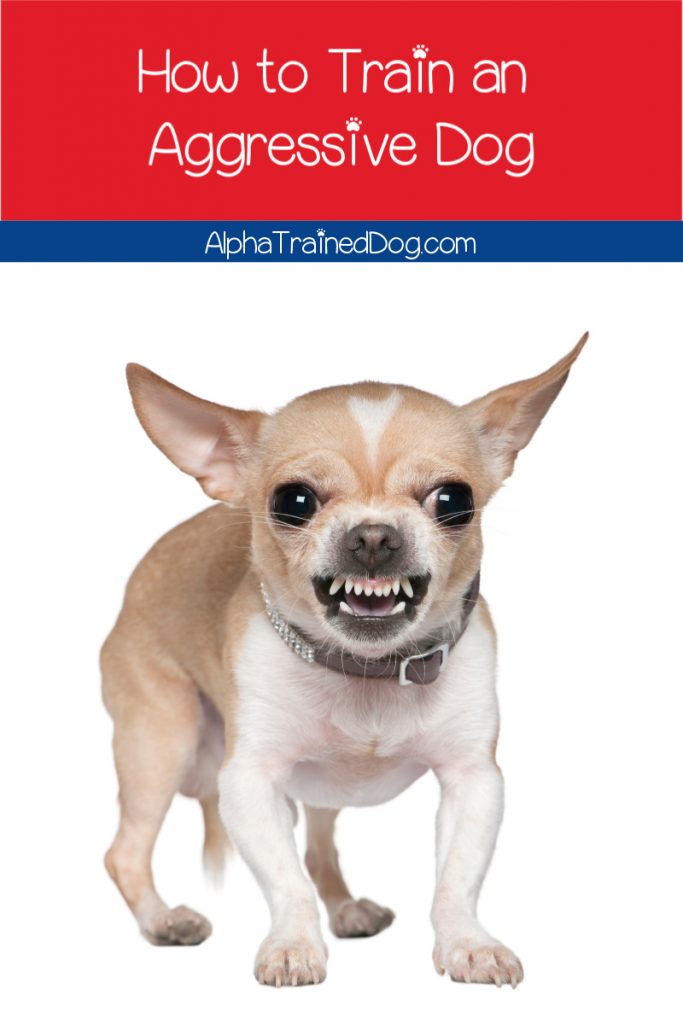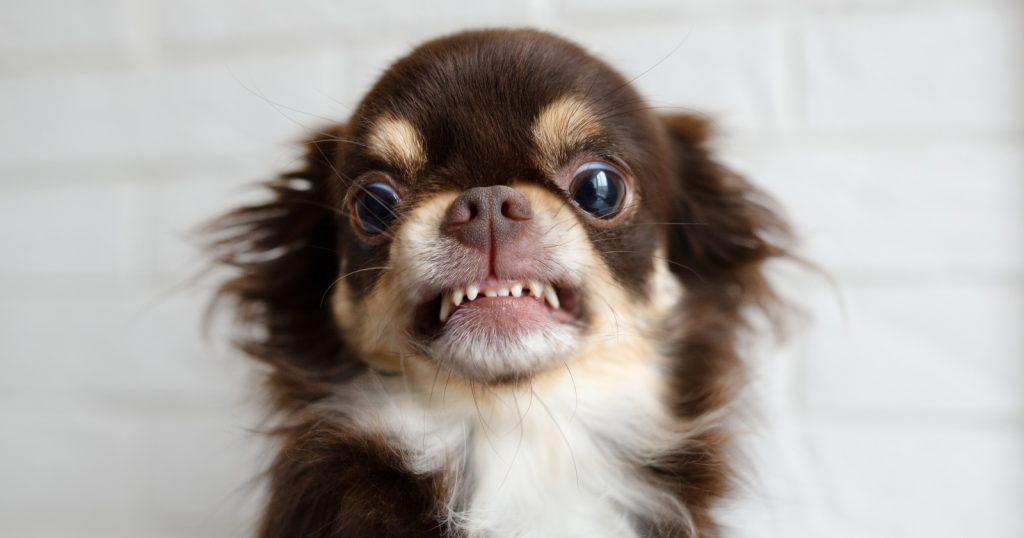Dogs come in all shapes and sizes with unique personalities and temperaments.
Some are bred and raised to be loving members of the family who can safely play with children, and some are trained to be loyal protectors.
But for every well-behaved pup, there’s also an ill-tempered or even aggressive dog.
Read on to learn how to deal train aggressive dogs, should you find yourself with one.
You may also like: What is Positive Reinforcement Dog Training?
How to Train Aggressive Dogs
No dog is born aggressive. Regardless of the breed, puppies are innately playful and curious.
Some canines may be wary or skittish, especially if they have had little to no human interaction, but they can slowly warm up to human caretakers, especially when motivated with food.
In the worst case, dogs who are not socialized will flee rather than show any aggression.

Where does a dog’s aggression originate?
There are many reasons, and most of them stem from their owner’s shortcomings or ignorance.
Aggression can be due to fear or possessiveness; thankfully, these traits that can be handled early with proper training and attention.
However, if the owner fails to recognize these signs of aggression or simply does not address them, their dog can be destructive, attacking other animals, strangers, or even their owners.
It is still possible to train these aggressive dogs and turn them into the loyal, loving companion you’ve always wanted.
This article will address how to recognize aggression in dogs and how to properly train them.
Recognizing Aggressive Behaviors in Dogs

The key to identifying signs of aggression in your dog is to pay attention.
You may come home to a sweet cuddle bug daily, but during feeding time, your sweet pup may turn into a terror.
By paying attention, you’ll see signs ahead of time and address them before the behavior gets worse.
Watch their body language closely
Before the barking, growling or biting, you’ll see signs of aggression through their body language.
If they tend to lock gaze and take a taller, more intimidating stance, they are asserting their dominance.
If not addressed properly, what follows could be growling and barking to get what they want.
If they don’t get their way, they can snap, nip, and bite at other dogs or even you.
Establishing dominance
Even if you only have one dog in your household, you and your family are his pack.
If there’s no clear alpha, your dog may become aggressive and attempt to establish dominance over the family.
Here, they may attack with little provocation.
Fear or possessiveness
If your dog’s aggression doesn’t stem from establishing their pack hierarchy, then maybe fear, anxiety, or possessiveness causes it.
Dogs who have already accepted their role in the pack can still become aggressive.
When they’re cornered or confronted by their pack leader, usually their owner, they can be fearful and anxious, leading to a fight or flight response.
While it’s important to check for signs of aggression, it is even more imperative to address them through training.
Do understand you are not “punishing” aggression; you are training them to behave properly, to distract them from triggers, and to reward their good behavior in the process.
Punishing an aggressive dog involves aggression, and while you may think that this works at first, it simply leads to fear, which would then result in aggression or other negative behaviors.
The following can provide a more positive approach to handling a dog’s aggression.
1. Proper Leash Training
An effective way to curb your dog’s aggression is to keep them from establishing dominance or claiming the alpha status.
The best way to do this is to establish yourself as alpha without being too aggressive.
Fortunately, one effective way to do that is with a leash.
This is not only a tool to control your dogs when you’re out on promenades, or a means of restricting their movement in certain environments.
With proper leash training, it’s an excellent way to establish your dominance.
Your day may start with a morning outing. During this time, you should learn to use the leash to control and restrict your pet’s movement.
This way, you are dictating the pace of the walk and not them.
Dogs usually decide where to go and when to stop and smell the surroundings; when a dog strains against the leash to do this, use it to calmly yet firmly restrain them until they relax; once relaxed, you can give them the signal to sniff around and investigate.
In a way, you are permitting them to do what they want, but only when they’re relaxed.
Inside the home, leash training can be used to curb negative behaviors that could also lead to aggression.
For example, your dog may be aggressive and strive to dominate other pets in the house.
By keeping the leash on your aggressive dog, you can give them a nudge once they show signs of aggression, like snarling and showing teeth.
You can also use it to keep them from claiming spaces and becoming territorial. Stepping on their leash works similarly to what you do on walks, but you can use it to curb the undesired behavior.
Leash training takes time and commitment, but it can chip away the aggressive behavior.
The leash becomes a tool to show your dog you’re in control, but in a way that you’re not acting aggressive towards them.
With the leash, they’re not free to do whatever they want, and they learn to regard you as the leader of the pack.
2. Food and Playtime
As an extension of your leash training, you can also train an aggressive dog with food and playtime.
Food and toys can be triggers for aggression to some dogs, especially if you have other dogs in your house.
They can become possessive or territorial, and this could lead to establishing dominance and fights.
What you can do as the alpha of the pack is to lead during these crucial times.
With food, since you’re the alpha, you get to decide when a pack member should eat. If you notice signs of aggression in your dog, you can assert your dominance by feeding him last.
At first, he may struggle with this, so you can put him in a crate or a separate area while you feed your other dogs.
While working with your dog on aggression, toys should be considered a reward for good behavior, so it is important to store them where your dogs cannot get to them.
When playtime is done, put the toy away. Once your dog is trained to not be aggressive, toys can come out of storage to be played with freely.
Training aggressive dogs takes time, effort, and consistency.
It could take weeks, months, or even years to correct undesirable behaviors.
It is important for you as the owner and alpha to stay consistent in training; if not, your pet could regress into the behavior you’ve worked so hard to change.
All dogs can be good dogs with the right training and a patient, steady owner.



My friend has an aggressive dog, I will def forward this post to her.